Values
m (Robot: Adding {{HOTwiki_navbar}}\n{{HOTwiki}}) |
|||
| (One intermediate revision by one user not shown) | |||
| Line 60: | Line 60: | ||
Draft rubrics for Mercy Value - Justice<br/>[[File:StLeosCoreMercyValue Justice Page 1.jpg|RTENOTITLE]]<br/>[[File:StLeosCoreMercyValue Justice Page 8.jpg|RTENOTITLE]][[File:StLeosCoreMercyValue Justice Page 7.jpg|RTENOTITLE]][[File:StLeosCoreMercyValue Justice Page 6.jpg|RTENOTITLE]][[File:StLeosCoreMercyValue Justice Page 5.jpg|RTENOTITLE]][[File:StLeosCoreMercyValue Justice Page 4.jpg|RTENOTITLE]][[File:StLeosCoreMercyValue Justice Page 3.jpg|RTENOTITLE]][[File:StLeosCoreMercyValue Justice Page 2.jpg|RTENOTITLE]]<br/>[[File:HOT symbol (150 x 79).jpg|right|HOT symbol (150 x 79).jpg]] | Draft rubrics for Mercy Value - Justice<br/>[[File:StLeosCoreMercyValue Justice Page 1.jpg|RTENOTITLE]]<br/>[[File:StLeosCoreMercyValue Justice Page 8.jpg|RTENOTITLE]][[File:StLeosCoreMercyValue Justice Page 7.jpg|RTENOTITLE]][[File:StLeosCoreMercyValue Justice Page 6.jpg|RTENOTITLE]][[File:StLeosCoreMercyValue Justice Page 5.jpg|RTENOTITLE]][[File:StLeosCoreMercyValue Justice Page 4.jpg|RTENOTITLE]][[File:StLeosCoreMercyValue Justice Page 3.jpg|RTENOTITLE]][[File:StLeosCoreMercyValue Justice Page 2.jpg|RTENOTITLE]]<br/>[[File:HOT symbol (150 x 79).jpg|right|HOT symbol (150 x 79).jpg]] | ||
| + | {{HOTwiki_navbar}} | ||
| + | {{HOTwiki}} | ||
| + | |||
| + | [[Category:HOT Wiki]] | ||
Latest revision as of 15:34, 24 January 2012
Contents |
Values
Excellence, Innovation, Inquiry and curiosity, Diversity; Equity; Community and participation; Ecological sustainability; Integrity; Respect.
What does it mean for teaching and learning in New Zealand Schools if these are the values to be encouraged, modelled and explored in the New Zealand Curriculum ?
How do we learn values?
How do we learn values in school?
How do we learn values in the classroom?
How do we know, understand and do values?
How do we know, understand and do values in school?
How do we know, understand and do values in the classroom?
How do we teach for knowing, understanding and doing values?
How do we teach for knowing, understanding and doing values in school?
How do we teach for knowing, understanding and doing values in the classroom?
We need to think carefully about acculturation and enculturation before we start.
Acculturation and enculturation
Acculturation of metacognitive reflection, through learning experiences designed to force a student to adopt the norms of thinking about thinking differs from enculturation approaches, where students are allowed to form and negotiate the norms and meanings of thinking about thinking in a learning community
When an instructional approach framed upon “acculturation” of attitudes and values of thinking is favoured, few students become strategic or reflective users of thinking skills. McGuinness claims that teaching through explicit instruction of metacognitive skills in isolation is a limiting pedagogy.
Developing better thinking and reasoning skills may have as much to do with creating dispositions for “good thinking” as it has for acquiring specific skills and strategies. For this reason classrooms need to have open-minded attitudes about the nature of knowledge and thinking and to create an educational atmosphere where talking about thinking – questioning, predicting, contradicting, doubting – is not only tolerated but actively pursued, (McGuiness, 1999)
Schools might attempt enculturation by enhancing classroom environments that encourage the key competencies of managing self, participating and contributing, or the dispositions of intellectual risk taking, sustained intellectual curiosity, clarity, strategic planning, intellectual rigour, metacognitive reflection, and valuing the student question, (Paul and Elder 2002, p19, Claxton and Lucas 2004 p24, Costa and Kallick 2000, p.8, and Marzano 1992, pp.131). New Zealand schools have approached thinking about thinking through acculturation and enculturation: Habits of Mind, (Costa and Kallick 2000); valuing student questions; “Ignorance Logging” – the tracking and evaluating of students “known unknown questions (Witte, 2002); Philosophy for Children, and by creating contexts for moral education through a community of enquiry (Fisher, 2003). Future Problem Solving and Community Problem Solving have provided an enculturation milieu of thinking for able students, (Rogalla, 2003). However, regardless of the nature of the intervention (cognitive thinking skill and or affective dispositions) when interventions attempt to acculturate thinking in a separate programme, their success has only “limited hard independent evidence” of their effectives in enhancing student thinking processes, (Wegerif 2002 p.17).
The challenge with learning through enculturation is ensuring that “moulding” environments are available to all students, and that environments allow the free establishment of thinking values and dispositions rather than the imposition of values and disposition. Enculturation too easily becomes indoctrination - the antithesis of thinking. Fraser (2004) articulates a similar concern over values education programmes claiming, “long term benefits of such programmes are not conclusive and the short term gains are equally elusive/unclear.” (Hook 2006)
Encourage, model and explore
Excellence
Innovation
Inquiry and curiosity
Diversity
Equity
Community and participation
Ecological sustainability
Integrity
Respect.
Core Mercy Values
An example of how we are working with St Leos School to create SOLO Taxonomy based rubrics to help students self assess themselves in terms of the Core Mercy Values in education, and the Key Competencies.
Each Mercy Value - Justice, Service, Respect for Human Dignity, Compassion, Care of the Poor and the Vulnerable - has been coded against the NZC Key Competencies.
Each Mercy Value dimension has been developed into a SOLO Taxonomy criterion based rubric.
These rubrics will form the basis for teacher and student discussion around the Mercy Values. The language and context will be altered to align with student understanding and student exemplars will be co-constructed with students.
Draft rubrics for Mercy Value - Justice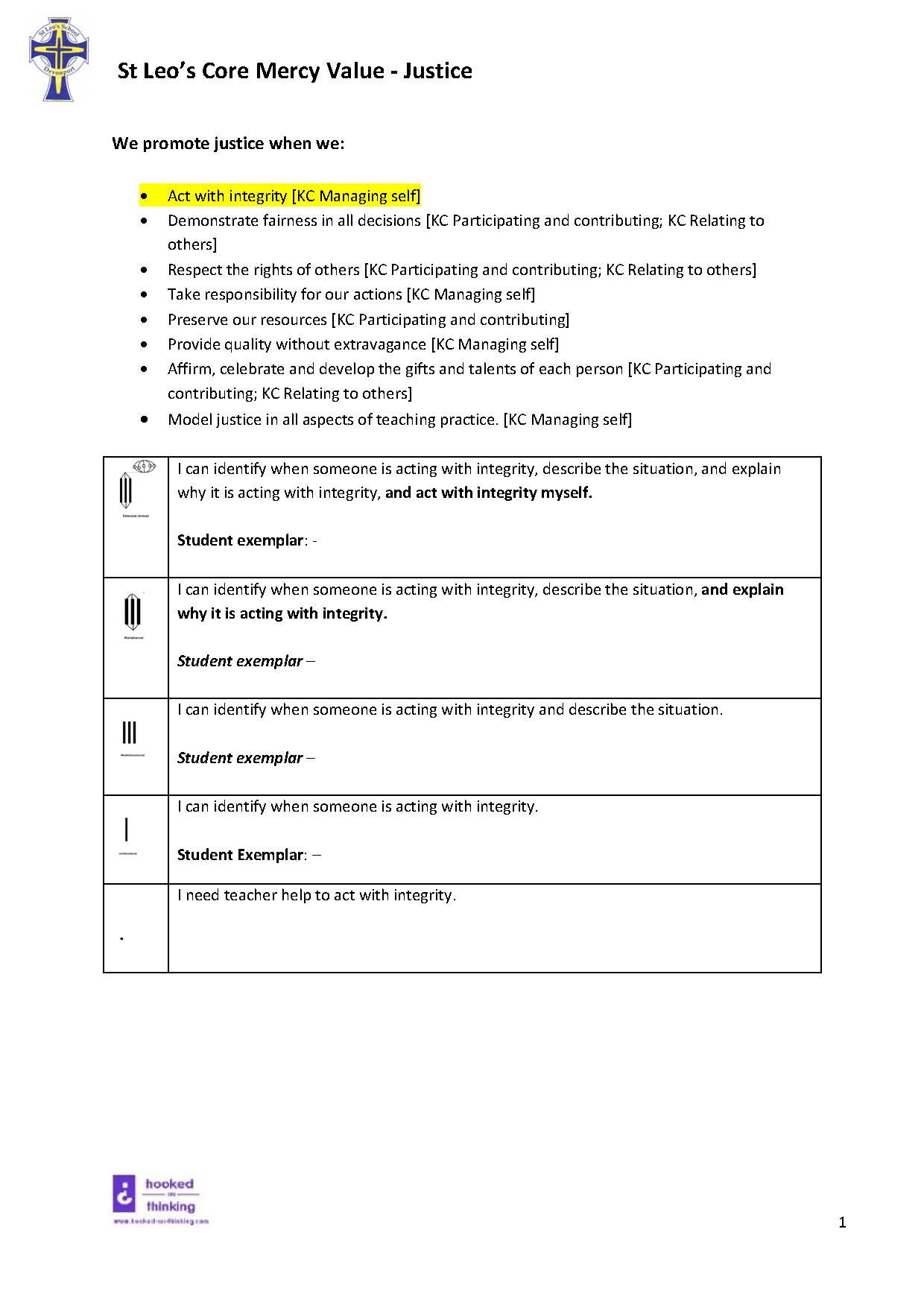

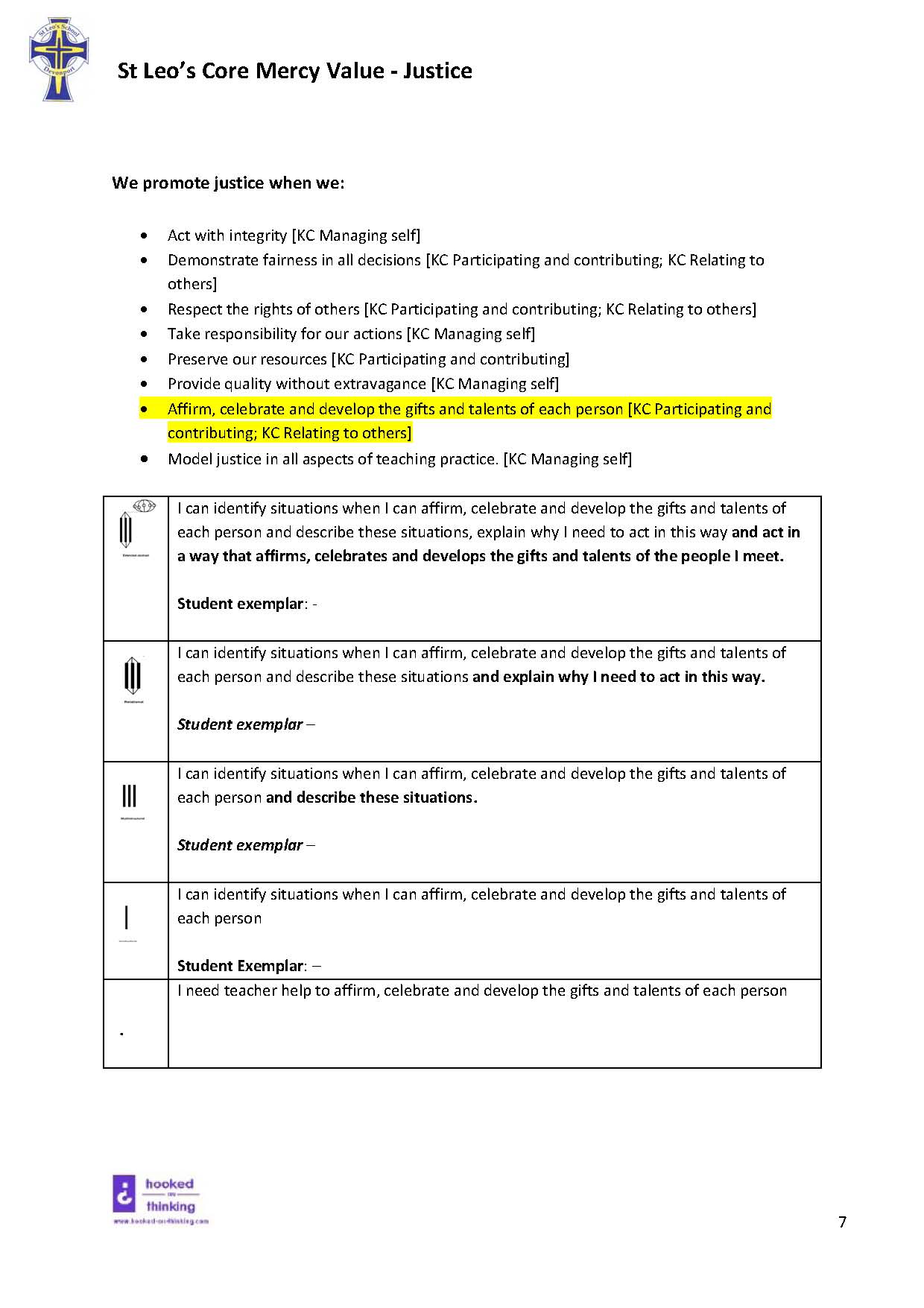
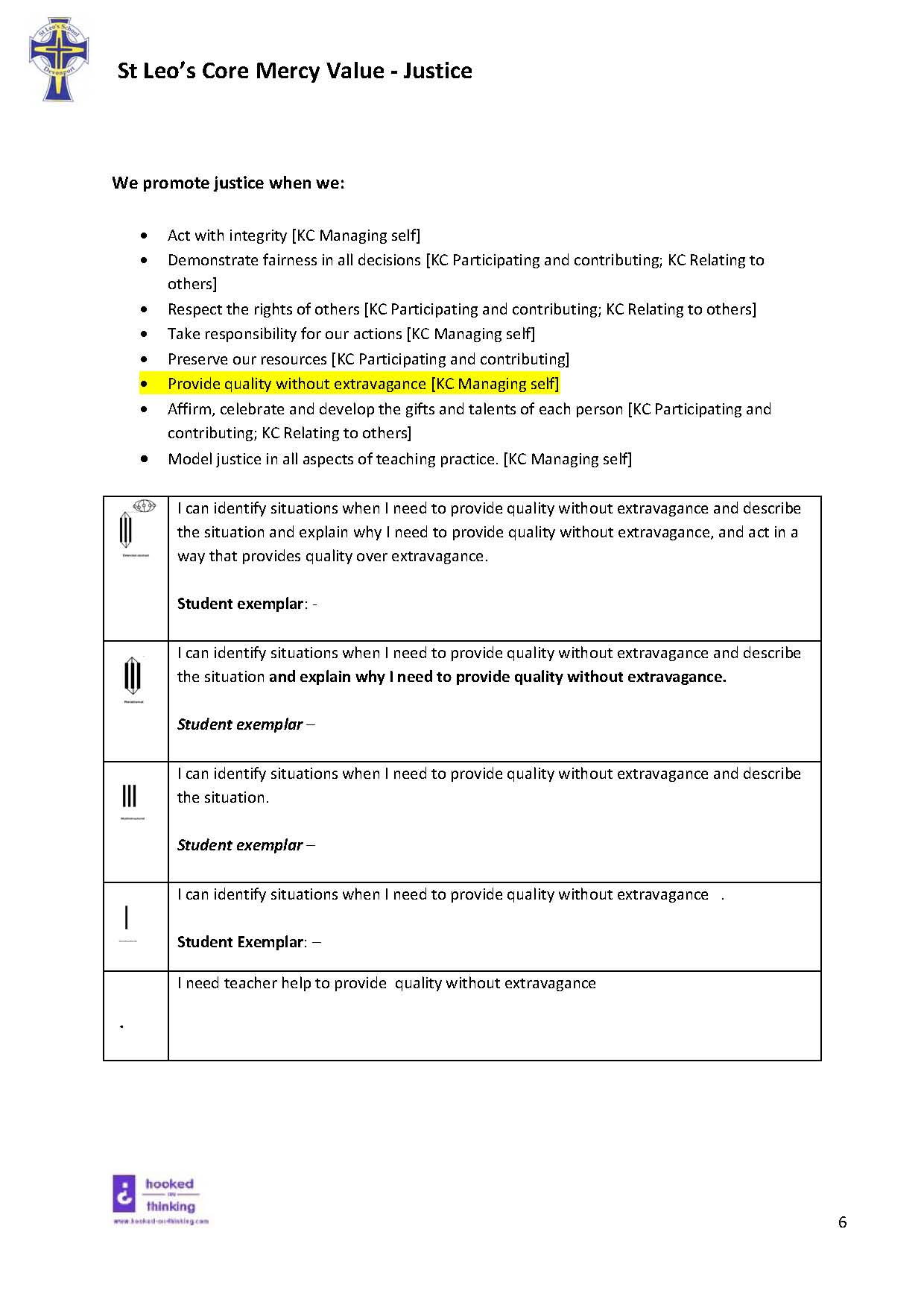
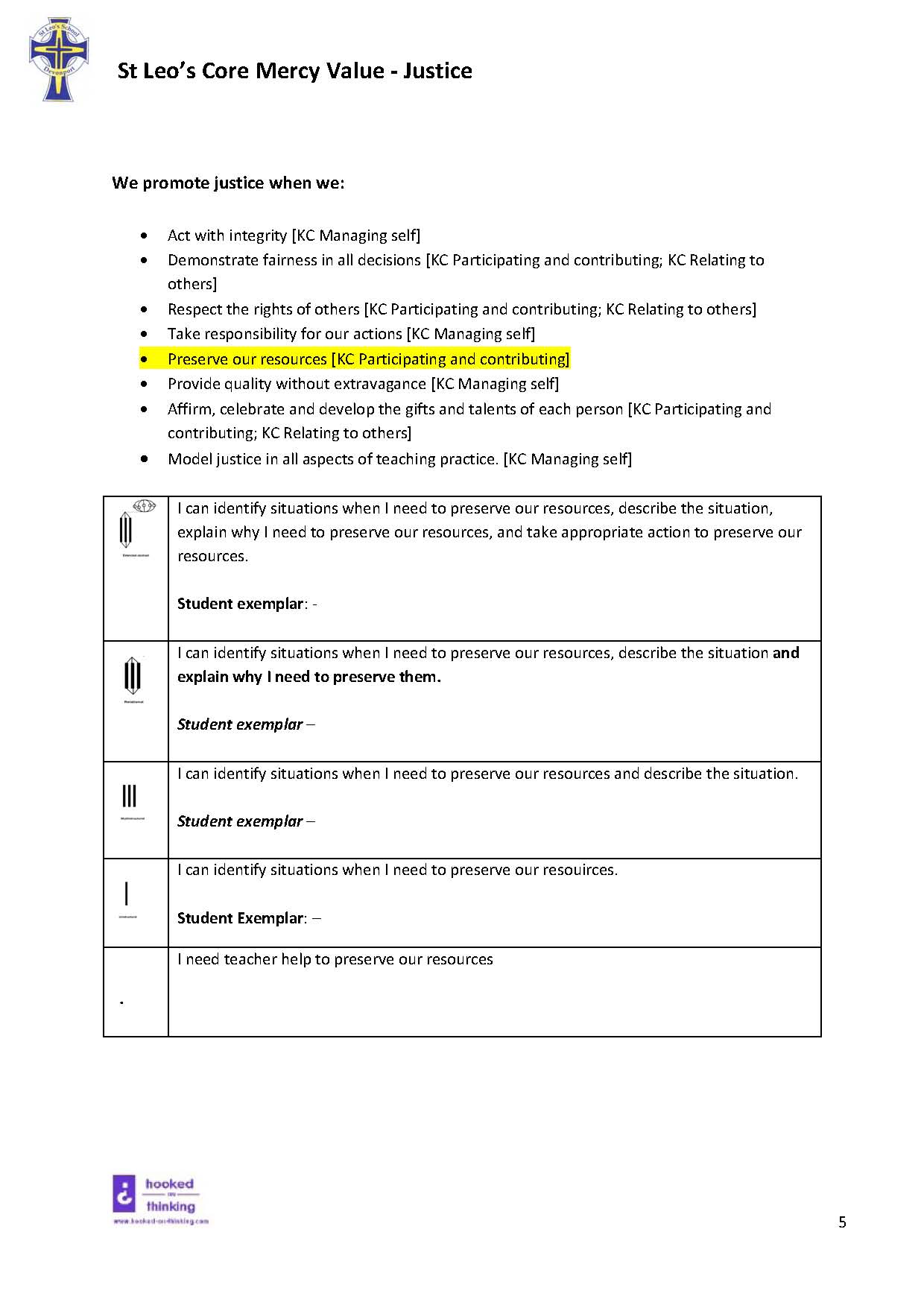


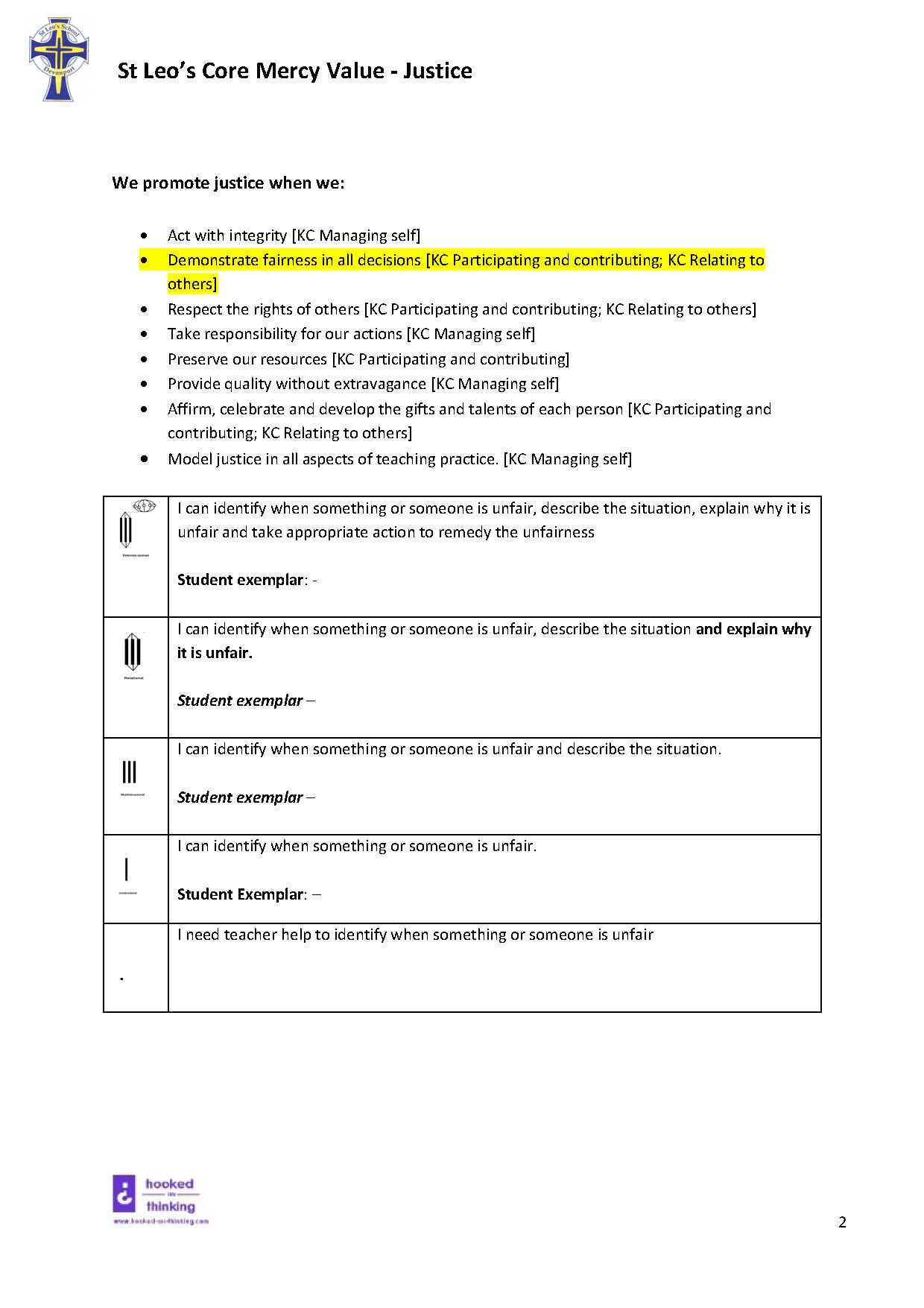
| ||||||||||||||||||||||||||||||||||||
Copyright © Hooked on Thinking. Pam Hook and Julie Mills, 2004 to 2011. All rights reserved.
Unless clearly stated otherwise, copyright material contained on this site is the intellectual property of Hooked on Thinking, Pam Hook and Julie Mills.
You may not use this work for commercial purposes. You may not alter, transform, or build upon this work without the written permission of the rights owner.

